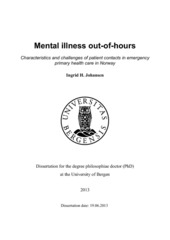| dc.contributor.author | Johansen, Ingrid Hjulstad | en_US |
| dc.date.accessioned | 2013-08-15T09:43:01Z | |
| dc.date.available | 2013-08-15T09:43:01Z | |
| dc.date.issued | 2013-06-19 | eng |
| dc.identifier.isbn | 978-82-308-2306-4 | en_US |
| dc.identifier.uri | https://hdl.handle.net/1956/6954 | |
| dc.description.abstract | In Norway there has been a call for improvement of the existing emergency mental health care services. Improvement of services needs to be built on knowledge and understanding of existing services, but in-depth knowledge about the role of the traditional low threshold out-of-hours emergency primary health care services (casualty clinics) has previously not been available. Thus the aim of this thesis was to describe mental illness related contacts to Norwegian casualty clinics, including the challenges general practitioners (GPs) experience in their out-of-hours’ work. This thesis is based on the results from three epidemiological and one qualitative study exploring different aspects of care provision in casualty clinics. The first study describes diagnoses given in contacts to one town-based and one inter-municipal rural casualty clinic throughout a year (n = 27 208). Gender and age characteristics of the patients and variations in time of presentation were explored. The second study compares daytime contacts to regular general practitioners’ (RGPs’) surgeries (n = 61 783) against contacts to the local casualty clinic (n = 11 976) over a year, focusing on diagnoses given, patient characteristics and simultaneous use of the two services at a group and an individual level. The third study observes routinely reported urgency levels, interventions and onwards referrals in contacts related to mental illness, for four Norwegian casualty clinics (28 527 initial contacts, 887 GP contacts judged to be related to mental illness or substance abuse). The fourth and last study is a qualitative study, based on six focus groups and two individual interviews (45 informants in total), that explores GPs’ experiences in casualty clinic contacts with patients who present problems related to mental illness or substance abuse. The studies showed that in 2006 there were 9-11 contacts with diagnoses signalling mental illness per 1000 inhabitants per year. In 30-68% of contacts judged by the GP to be related to mental illness or substance abuse such diagnoses were not given. Contacts to the casualty clinic increased in periods with few contacts to the RGPs’ surgeries (r = -0.59, p = 0.05). At least 74% of patients contacting the casualty clinic had seen their RGP during the study year. The diagnostic profile out-of-hours had a higher relative prevalence of suicidal behaviour (relative risk (RR) 81.8), psychosis (RR 2.5) and substance abuse (RR 2.0) compared to the profile at the RGPs’ surgeries. The diagnoses P16 (acute alcohol abuse) and P77 (suicide and suicide attempt) also had higher absolute prevalence at the casualty clinic compared to at the RGPs’ surgeries. Contacts related to substance abuse were particularly prevalent during night-time, and included a group of patients presenting with injuries and medical consequences of substance abuse. 79% of contacts to the casualty clinics were handled without referral to in-patient care, and 17% of patients judged by health personnel to contact the casualty clinic due to mental health problems were referred to in-patient (14%) or out-patient (3%) psychiatric specialist care. The GPs expressed experiencing uncertainty in contacts related to mental illness, and they emphasised the importance of access to immediate support from colleges. Worry over their own safety was also an issue. This thesis shows that there are few mental health related contacts to casualty clinics, and that a minority of the contacts result in involvement of secondary mental health care services. This questions the viability of additional or specialist out-of-hours mental health care services. Nevertheless, if the traditional structure is kept, the out-ofhours support framework for GPs needs to be strengthened. | en_US |
| dc.language.iso | eng | eng |
| dc.publisher | The University of Bergen | eng |
| dc.relation.haspart | Paper I: Johansen IH, Morken T, Hunskaar S. Contacts related to psychiatry and substance abuse in Norwegian casualty clinics. A cross-sectional study. Scand J Prim Health Care 2009; 27: 180-5. Full-text not available in BORA due to publisher restrictions. The published version is available at: <a href="http://dx.doi.org/10.1080/02813430903075473" target="blank">http://dx.doi.org/10.1080/02813430903075473</a> | en_US |
| dc.relation.haspart | Paper II: Johansen IH, Morken T, Hunskaar S. Contacts related to mental illness and substance abuse in primary health care. A cross-sectional study comparing patients’ use of daytime versus out-of-hours primary care in Norway. Scand J Prim Health Care 2010; 28: 160-5. Full-text not available in BORA due to publisher restrictions. The published version is available at: <a href="http://dx.doi.org/10.3109/02813432.2010.493310" target="blank">http://dx.doi.org/10.3109/02813432.2010.493310</a> | en_US |
| dc.relation.haspart | Paper III: Johansen IH, Morken T, Hunskaar S. How Norwegian casualty clinics handle contacts related to mental illness: A prospective observational study. Int J Ment Health Syst 2012; 6: 3. The article is available at: <a href="http://hdl.handle.net/1956/6953" target="blank">http://hdl.handle.net/1956/6953</a> | en_US |
| dc.relation.haspart | Paper IV: Johansen IH, Carlsen B, Hunskaar S. Psychiatry out-of-hours: a focus group study of GPs’ experiences in Norwegian casualty clinics. BMC Health Serv Res 2011; 11: 132. The article is available at: <a href="http://hdl.handle.net/1956/5488" target="blank">http://hdl.handle.net/1956/5488</a> | en_US |
| dc.title | Mental illness out-of-hours. Characteristics and challenges of patient contacts in emergency primary health care in Norway | en_US |
| dc.type | Doctoral thesis | |
| dc.rights.holder | Copyright the author. All rights reserved | |
